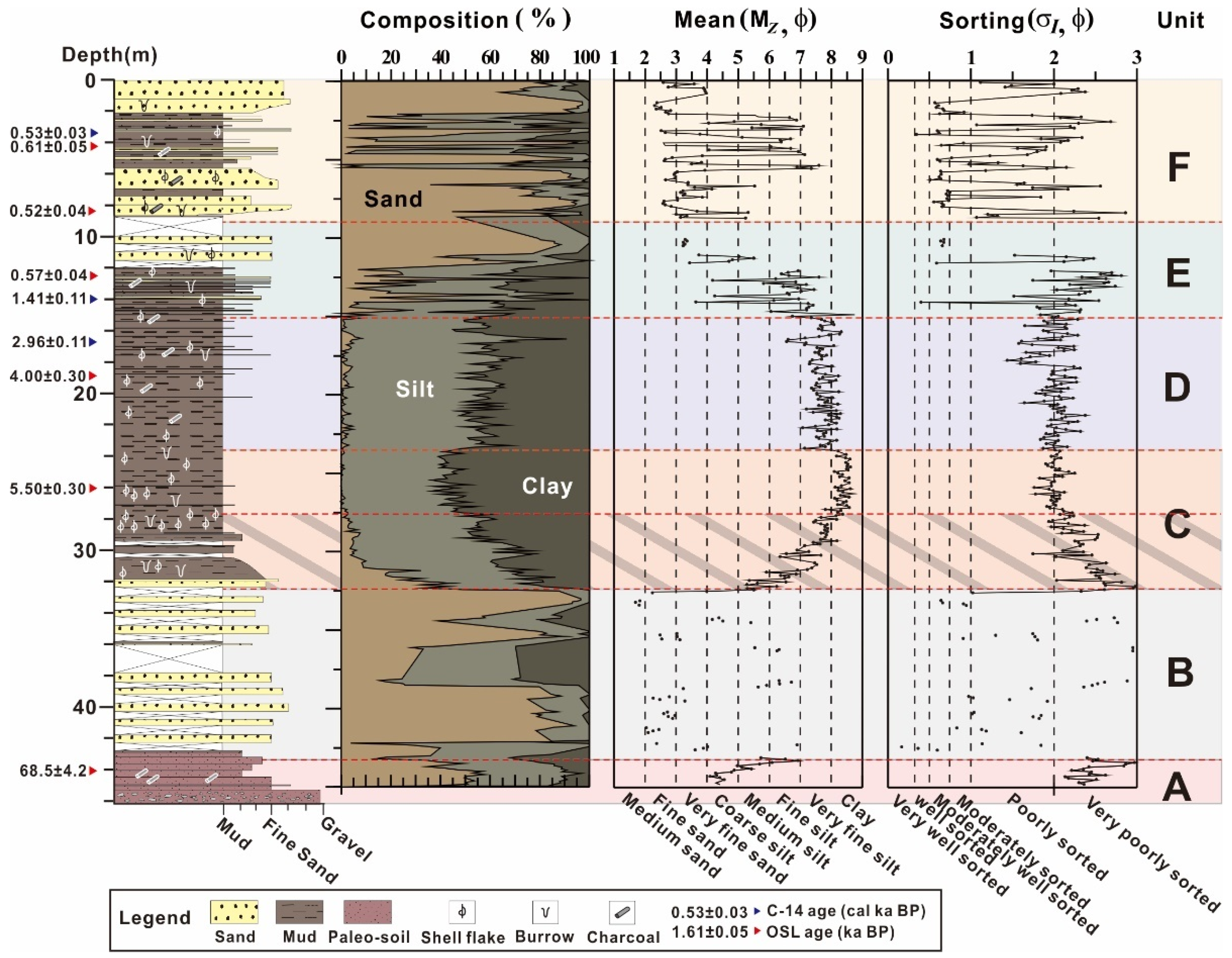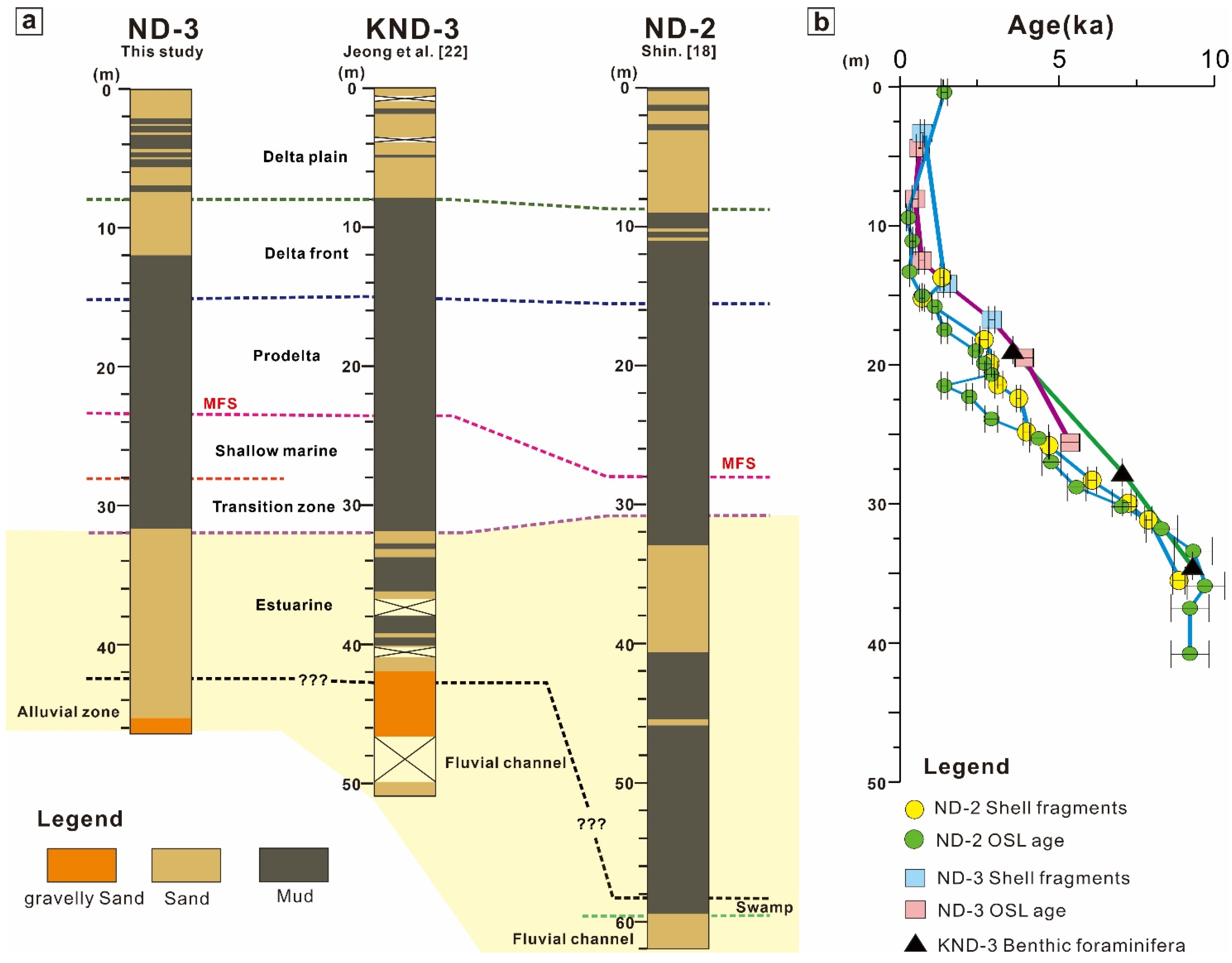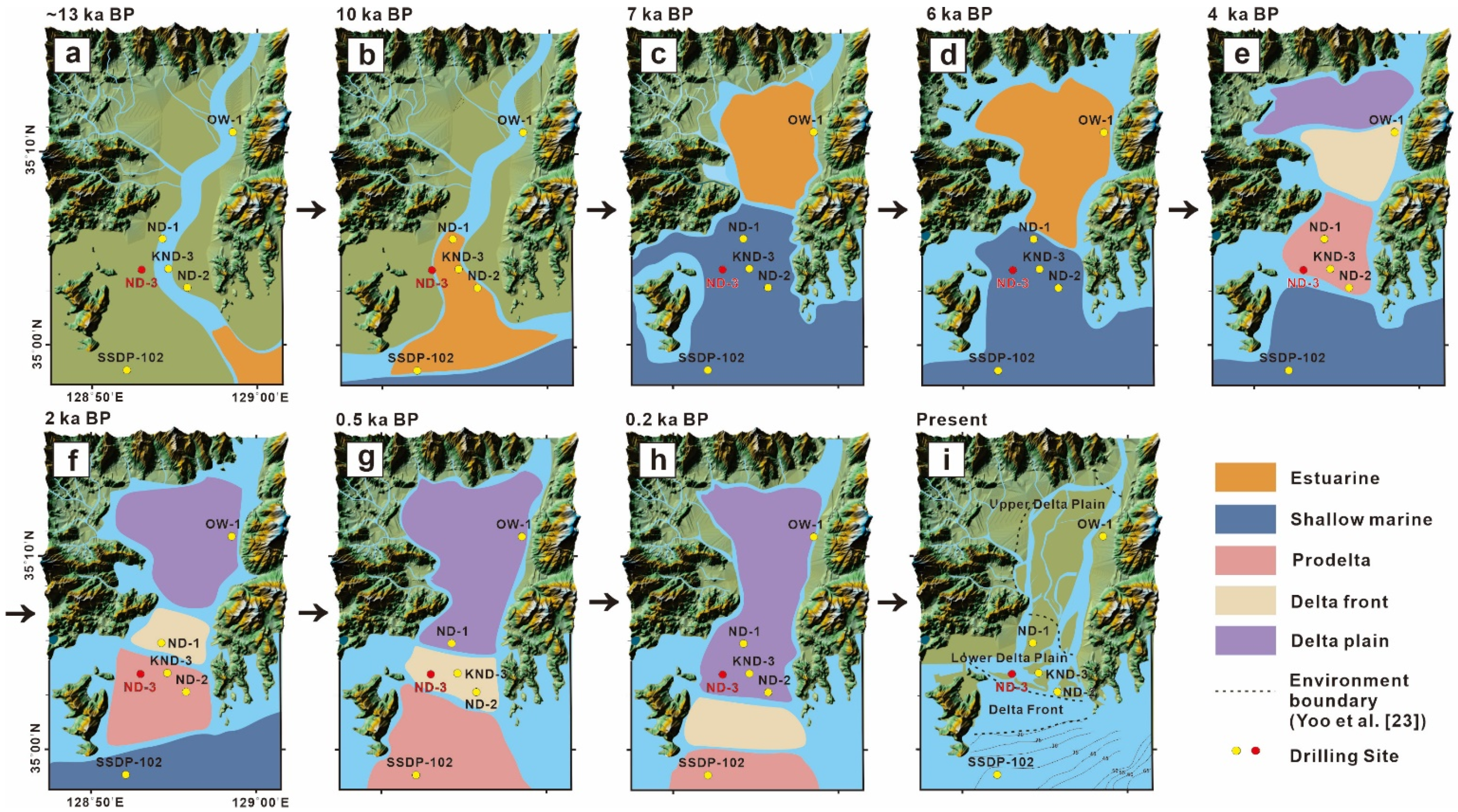Evolution of Depositional Environments in Response to the Holocene Sea-Level Change in the Lower Delta Plain of Nakdong River Delta, Korea
Abstract
1. Introduction
2. Regional Setting
3. Materials and Methods
3.1. Age Dating
3.2. Grain Size Analysis
4. Results
4.1. Classification of Sedimentary Units
4.1.1. Unit A (Depth in Core: 46.60–43.16 m)
4.1.2. Unit B (Depth in Core: 43.16–32.20 m)
4.1.3. Unit C (Depth in Core: 32.20–23.50 m)
4.1.4. Unit D (Depth in Core: 23.50–15.10 m)
4.1.5. Unit E (Depth in Core: 15.10–8.00 m)
4.1.6. Unit F (Depth in Core: 8.00–0.00 m)
4.2. Depositional Ages
5. Discussion
5.1. Depositional Interpretation of Sedimentary Units
5.1.1. Alluvial Zone
5.1.2. Estuarine Zone
5.1.3. Shallow Marine
5.1.4. Prodelta
5.1.5. Delta Front
5.1.6. Delta Plain
5.2. Correlation between ND-3, KND-3, and ND-2 Cores in the Lower Delta Plain
5.3. Evolution History of the Nakdong River Delta
5.3.1. Last Glacial Maximum—6 cal ka BP (Retrogradation Phase)
5.3.2. After 6 cal ka BP (Progradation Phase)
6. Conclusions
- A total of six sedimentary units (A, B, C, D, E, and F) were identified in the ND-3 core (46.60 m long) sediments. These classifications suggested that the Nakdong River delta contains a typical progradational sedimentary facies, starting from the late Pleistocene paleosol in the lowermost core sediments and migrating into the Holocene sediments characterized by shallow marine, prodelta, delta front, and the delta plain deposits toward the upper part of the core sediments.
- For the study of different sediment distribution among the Nakdong River delta cores, we compared the ND-3 sediments with KND-3, and ND-2 core sediments, which are located at the same elevation as the ND-3 core sediments. We found that the sedimentary facies and grain size distributions are similar between the three cores. However, the ND-3 samples were found to be older than the ND-2 sediments. We also realized a relief in paleo-geomorphology between the ND-2, KND-3, and ND-3 cores through different paleosol observation levels. Unlike the muddy estuary sediments of the ND-2 and KND-3 core, the ND-3 core sediments contain a large amount of sandy sediments. The reason is that ND-3 core sediments were probably deposited at a bayhead delta environment.
- The periodic growth process of the Nakdong River delta was reconstructed by referring the previous studies. At 10 cal ka BP, when transgression occurred because of a rapid increase in sea level up to 30 m below the current level, the coastline was located at the lower part of the present Nakdong River delta and the estuary’s settings were formed at the ND-1, 2, 3, and KND-3 drilling sites. At 8–6 cal ka BP, sea-level rose abruptly and most of the current delta plains became submerged by seawater, changing into a continental shelf environment. After 6 cal ka BP, when the sea level was similar to the present level, most of the Gimhae Plain was located in a shallow marine environment and the terrestrial sediments supplied by the Nakdong River were prograded and deposited to form the initial Nakdong River delta system. After 2 cal ka BP, the deltaic sediments were prograded and deposited, and most of the delta was formed in the present shape of the delta and the delta plain environment.
Author Contributions
Funding
Institutional Review Board Statement
Informed Consent Statement
Data Availability Statement
Conflicts of Interest
References
- Gao, S. Modeling the growth limit of the Changjiang Delta. Geomorphology 2007, 85, 225–236. [Google Scholar] [CrossRef]
- Hori, K.; Saito, Y. An early Holocene sea-level jump and delta initiation. Geophys. Res. Lett. 2007, 34, 1–5. [Google Scholar] [CrossRef]
- Xu, Q.; Yand, J.; Yuan, G.; Chu, Z.; Zhang, Z. Stratigraphic sequence and episodes of the ancient Huanghe Delta along the southwestern Bohai Bay since the LGM. Mar. Geol. 2015, 367, 69–82. [Google Scholar] [CrossRef]
- Hori, K.; Tanabe, S.; Saito, Y.; Haruyama, S.; Nguyen, V.; Kitamura, A. Delta initiation and Holocene sea-level change: Example from the Song Hong (Red River) delta, Vietnam. Sediment. Geol. 2004, 164, 237–249. [Google Scholar] [CrossRef]
- Hori, K.; Saito, Y.; Zhao, Q.; Wang, P. Architecture and evolution of the tide-dominated Changjiang (Yangtze) River delta, China. Sediment. Geol. 2002, 146, 249–264. [Google Scholar] [CrossRef]
- Tanabe, S.; Saito, Y.; Sato, Y.; Suzuki, Y.; Sinsakul, S.; Tiyapairach, S.; Chaimanee, N. Stratigraphy and Holocene evolution of the mud-dominated Chao Phraya delta, Thailand. Quat. Sci. Rev. 2003, 22, 789–807. [Google Scholar] [CrossRef]
- Ta, T.K.O.; Nguyen, V.L.; Tateishi, M.; Kobayashi, I.; Saito, Y. Holocene delta evolution and depositional models of the Mekong River Delta, southern Vietnam. Soc. Sediment. Geol. 2005, 83, 453–466. [Google Scholar]
- Hanebuth, T.J.; Proske, U.; Saito, Y.; Nguyen, V.L.; Ta, T.K.O. Early growth stage of a large delta—Transformation from estuarine-platform to deltaic-progradational conditions (the northeastern Mekong River Delta, Vietnam). Sediment. Geol. 2012, 261, 108–119. [Google Scholar] [CrossRef]
- Zong, Y.; Huang, K.; Yu, F.; Zheng, Z.; Switzer, A.; Huang, G.; Wang, N.; Tang, M. The role of sea-level rise, monsoonal discharge and the palaeo-landscape in the early Holocene evolution of the Pearl River delta, southern China. Quat. Sci. Rev. 2012, 54, 77–88. [Google Scholar] [CrossRef]
- Song, B.; Li, Z.; Saito, Y.; Okuno, J.I.; Lu, A.; Hua, D.; Li, J.; Li, Y.; Nakashima, R. Initiation of the Changjiang (Yangtze) delta and its response to the mid-Holocene sea level change. Paleogeogr. Palaeoclimatol. Palaeoecol. 2013, 388, 81–97. [Google Scholar] [CrossRef]
- Xu, T.; Shi, X.; Wang, G.; Qiao, S.; Yang, G.; Liu, S.; Wang, X.; Zhao, Q. Sedimentary facies of the subaqueous Changjiang River delta since the late Pleistocene. Chin. J. Oceanol. Limnol. 2013, 31, 1107–1119. [Google Scholar] [CrossRef]
- Wei, X.; Wu, C.; Ni, P.; Mo, W. Holocene delta evolution and sediment flux of the Pearl River, southern China. J. Quat. Sci. 2016, 31, 484–494. [Google Scholar] [CrossRef]
- Ryu, C.K. Engineering Geological Characteristics of the Holocene Marine Clayey Sediments in the Estuary of Nagdong River. Ph.D. Thesis, Pusan National University, Pusan, Korea, 2003. (In Korean with English abstract). [Google Scholar]
- Ryu, C.K.; Kang, S.; Chung, S.G. Late Quaternary Paleoenvironmental Changes in the Western Nakdong River delta. J. Korean Earth Sci. Soc. 2005, 26, 443–458, (In Korean with English abstract). [Google Scholar]
- Ryu, C.K.; Kang, S.; Chung, S.G.; Jeon, Y.M. Late Quaternary depositional environmental change in the northern marginal area of the Nakdong River delta. J. Geol. Soc. Korea 2011, 47, 213–233, (In Korean with English abstract). [Google Scholar]
- Yoo, D.G.; Chang, J.H.; Lee, H.Y.; Kim, S.P.; Nam, S.I.; Gong, K.S. Stratigraphy and depositional environment of Holocene deposits in the inner shelf off the Nakdong River mouth. J. Geol. Soc. Korea 2014, 40, 395–407, (In Korean with English abstract). [Google Scholar]
- Paik, S.; Cheong, D.; Shin, S.; Kim, J.C.; Park, Y.H.; Lim, H.S. A paleoenvironmental study of Holocene delta sediments in Nakdong River Estuary. J. Geol. Soc. Korea 2016, 52, 15–30, (In Korean with English abstract). [Google Scholar] [CrossRef]
- Shin, S. Sedimentary environment evolution analysis though core sediments in lake Hovsgol of the northern Mongolia and Nakdong Estuary, Korea. Ph.D. Thesis, Kangwon National University, Chuncheon, Korea, 2016. (In Korean with English abstract). [Google Scholar]
- Korea Institute of Geoscience and Mineral Resources. Study on the Late Quaternary Paleoclimate Changes, Using Deep-Drill Cores, in the Continental Shelf, South Sea; KIGAM: Daejeon, Korea, 2003; p. 316, (In Korean with English abstract). [Google Scholar]
- Chung, C.H.; Ryu, C.K. Holocene vegetation dynamics and its environmental implications inferred from pollen record in Gimhae area, Korea. J. Geol. Soc. Korea 2012, 48, 1–10, (In Korean with English abstract). [Google Scholar]
- Ham, A. Late Quaternary Depositional Environmental Changes from the Middle Part of Nakdong River Delta Sediments. Master’s Thesis, Kangwon National University, Chuncheon, Korea, 2016. (In Korean with English abstract). [Google Scholar]
- Jeong, E.J.; Woo, H.J.; Kang, J.; Lee, J.; Choi, J.U. Study of Holocene paleo-environmental evolution using cores from the downstream area of the Nakdong River Delta, Korea. J. Coast. Res. 2018, 85, 626–630. [Google Scholar] [CrossRef]
- Yoo, D.G.; Lee, G.S.; Kang, N.; Yi, B.Y.; Kong, G.S.; Kim, G.Y.; Chang, S.; Yi, S.; Kim, J.C. Stratigraphy and depositional history of Nakdong River Delta. J. Geol. Soc. Korea 2017, 53, 619–630. [Google Scholar] [CrossRef]
- Kwon, H.J. A Geomorphorphic Study of the Naktong Delta. Korean Geogr. Soc. 1973, 8, 8–23, (In Korean with English abstract). [Google Scholar]
- Kim, D.W.; Lee, H.H. Sediment Transport and Deposition in the Nagdong Estuary, Korea. J. Geol. Soc. Korea 1980, 16, 180–188, (In Korean with English abstract). [Google Scholar]
- Kim, S.H. The Morphological Changes of Deltaic Barrier Islands in the Nakdong River Estuary after the Construction of River Barrage. J. Korean Geogr. Soc. 2005, 40, 416–427, (In Korean with English abstract). [Google Scholar]
- Korea Hydrographic Oceanographic Agency. Research for Morphological Change in the Nakdong Estuary and Haeundae Beach; KHOA: Busan, Korea, 2010; p. 11, (In Korean with English abstract).
- Oh, G.H. Landform Changes of Terminal Area of the Nagdong River Delta, Korea. Korean J. Quat. Res. 1999, 13, 67–78, (In Korean with English abstract). [Google Scholar]
- Ramsey, C.B.; Lee, S. Recent and planned developments of the program OxCal. Radiocarbon 2013, 55, 720–730. [Google Scholar] [CrossRef]
- Reimer, P.J.; Bard, E.; Bayliss, A.; Beck, J.W.; Blackwell, P.G.; Ramsey, C.B.; Buck, C.E.; Cheng, H.; Edwards, R.L.; Friedrich, M.; et al. IntCal13 and Marine13 radiocarbon age calibration curves 0–50,000 years cal BP. Radiocarbon 2013, 55, 1869–1887. [Google Scholar] [CrossRef]
- Olley, J.M.; Murray, A.S.; Roberts, R.G. The effects of disequilibria in the uranium and thorium decay chains on burial dose rates in fluvial sediments. Quat. Geochronol. 1996, 15, 751–760. [Google Scholar] [CrossRef]
- Jeong, E.J. Evolution Study of Sedimentary Environents of Late Pleistocene Caused by Sea-Level Changes in the Nakdong River Estuary, Korea. Master’s Thesis, Kangwon National University, Chuncheon, Korea, 2017. (In Korean with English abstract). [Google Scholar]
- Khim, B.K.; Shin, S.; Kim, J.C. Sediment properties of lithologic units and their correlation within the lower delta plain of the Nakdong River Delta, Southeast Korea. Quat. Int. 2019, 519, 170–182. [Google Scholar] [CrossRef]
- Funabiki, A.; Haruyama, S.; Dinh, H.T. Holocene evolution of the Kumozu River delta, Mie Prefecture, central Japan. Quat. Res. (Daiyonki Kenkyu) 2010, 49, 201–218. [Google Scholar] [CrossRef][Green Version]
- Parton, T.R.; Humphrays, G.S.; Mitchell, P.B. Soils—A New Global View; UCL Press: London, UK, 1995; p. 213. [Google Scholar]
- Li, C.; Chen, Q.; Zhang, J.; Yang, S.; Fan, D. Stratigraphy and paleoenvironmental changes in the Yangtze Delta during the Late Quaternary. Earth Sci. 2000, 18, 453–469. [Google Scholar] [CrossRef]
- Cho, A.; Cheong, D.; Kim, J.C.; Shin, S.; Park, Y.H.; Katsuki, K. Delta formation in the Nakdong River, Korea, during the Holocene as inferred from the diatom assemblage. J. Coast. Res. 2016, 33, 67–77. [Google Scholar] [CrossRef]
- Tanabe, S.; Ta, T.K.O.; Nguyen, V.L.; Tateishi, M.; Kobayashi, I.; Saito, Y. Delta evolution model inferred from the holocene Mekong delta, southern Vietnam. In Tropical Deltas of Southeast Asia—Sedimentology, Stratigraphy, and Petroleum Geology; Sidi, F.H., Nummedal, D., Imbert, P., Darman, H., Posamentier, H.W., Eds.; SEPM Special Publication: Tulsa, OK, USA, 2003; Volume 76, pp. 175–188. [Google Scholar]
- Amorosi, A.; Dinelli, E.; Rossi, V.; Vaiani, S.C.; Sacchetto, M. Late Quaternary palaeoenvironmental evolution of the Adriatic coastal plain and the onset of Po River Delta. Palaeogeogr. Palaeoclimatol. Palaeoecol. 2008, 268, 80–90. [Google Scholar] [CrossRef]
- Reineck, H.E.; Singh, I.B. Depositional Sedimentary Environments; Springer: New York, NY, USA, 1980; p. 549. [Google Scholar]
- Yoo, D.G.; Kim, S.P.; Chang, T.S.; Kong, G.S.; Kang, N.K.; Kwon, Y.G.; Nam, S.L.; Park, S.C. Late Quaternary inner shelf deposits in response to late Pleistocene-Holocene sea level changes: Nakdong River, SE Korea. Quat. Int. 2014, 344, 156–169. [Google Scholar] [CrossRef]
- Fairbanks, R.G. A 17,000-year glacio-eustatic sea-level record: Influence of glacial melting rates on the younger Dryas event and deep-ocean circulation. Nature 1989, 342, 637–642. [Google Scholar] [CrossRef]
- Bard, E.; Hamelin, B.; Arnold, M.; Montaggioni, L.; Cabioch, G.; Faure, G.; Rougerie, F. Deglacial sea-level record from Tahiti corals and the timing of global meltwater discharge. Nature 1996, 382, 241–244. [Google Scholar] [CrossRef]
- Liu, J.P.; Milliman, J.D.; Gao, S.; Cheng, P. Holocene development of the Yellow River’s subaqueous delta, North Yellow Sea. Mar. Geol. 2004, 209, 45–67. [Google Scholar] [CrossRef]
- Bird, M.I.; Fifield, L.K.; Teh, T.S.; Chang, C.H.; Shirlaw, N.; Lambeck, K. An inflection in the rate of early mid-Holocene eustatic sea-level rise: A new sea-level curve from Singapore. Estuarine Coast. Shelf Sci. 2007, 71, 523–536. [Google Scholar] [CrossRef]
- Bird, M.I.; Austin, W.E.; Murster, C.M.; Fifield, L.K.; Mojtahid, M.; Sargeant, C. Punctuated eustatic sea-level rise in the early mid-Holocene. Geology 2010, 38, 803–806. [Google Scholar] [CrossRef]
- Hwang, S.I.; Kim, J.Y.; Yoon, S.O. Late Holocene Environmental Change and Geomorphological Development in the Northwestern Part of the Paleo-Gimhae Bay. J. Korean Geomorphol. Assoc. 2009, 16, 85–99, (In Korean with English abstract). [Google Scholar]
- Cho, H.R. Alluvial Plains in Korea; Gyohak Research Publisher: Seoul, Korea, 1987; p. 220. (In Korean) [Google Scholar]
- Song, B.; Yi, S.; Yu, S.Y.; Nahm, W.H.; Lee, J.Y.; Lim, J.; Kim, J.C.; Yang, Z.; Han, M.; Jo, K.; et al. Holocene relative sea-level changes inferred from multiple proxies on the west coast of South Korea. Palaeogeogr. Palaeoclimatol. Palaeoecol. 2018, 496, 268–281. [Google Scholar] [CrossRef]
- Hwang, S.I. The Holocene Depositional Environment and Sea-Level Change at Ilsan Area. J. Korean Geogr. Soc. 1998, 33, 143–163. (In Korean) [Google Scholar]
- Kim, J.W. Late Holocene Paleoenvironmental Change and Geomorphological Development in the North-West Paleo-Gimhae Bay. Master’s Thesis, Kyungpook National University, Daegu, Korea, 2008. (In Korean with English abstract). [Google Scholar]







| Sample No. | Dose Rate (Gy/ka) | Equivalent Dose (Gy) | Water Content (%) | Depth (m) | Used Disc Number | OSL Age (ka) |
|---|---|---|---|---|---|---|
| ND3 (4–4.8 m) | 3.57 ± 0.21 | 2.17 ± 0.12 | 31.7 | 4.40~4.45 | 5/5 | 0.61 ± 0.05 |
| ND3 (8–9 m) | 3.22 ± 0.17 | 1.68 ± 0.09 | 32.2 | 8.55~8.60 | 5/5 | 0.52 ± 0.04 |
| ND3 (12–13 m) | 3.27 ± 0.19 | 1.86 ± 0.09 | 37.6 | 12.50~12.55 | 5/5 | 0.57 ± 0.04 |
| ND3 (19.4–20.2 m) | 2.80 ± 0.17 | 11.12 ± 0.29 | 53.5 | 19.80~19.85 | 5/5 | 4.0 ± 0.3 |
| ND3 (25–25.8 m) | 2.32 ± 0.13 | 12.74 ± 0.14 | 57.5 | 25.40~25.45 | 5/5 | 5.5 ± 0.3 |
| ND3 (43.0–46.5 m) | 4.05 ± 0.25 | 277.40 ± 1.92 | 6.4 | 44.60~44.65 | 4/5 | 68.5 ± 4.2 |
| Sample No. | Material | Method | Delta 13C (per mil) | Conventional Age (yr BP) | Calibrated Age (cal yr BP) (1phi Age Range) | Laboratory Code |
|---|---|---|---|---|---|---|
| ND3 (3.26 m) | Shell fragment | AMS | 9 | 610 ± 60 | 500–560 | KGM-ITg161454 |
| ND3 (14.13 m) | Shell fragment | AMS | 1.5 | 1414 ± 110 | 1390–1450 | KGM-ITg161452 |
| ND3 (16.80 m) | Shell fragment | AMS | 3.2 | 2960 ± 110 | 2840–2920 | KGM-ITg161453 |
Publisher’s Note: MDPI stays neutral with regard to jurisdictional claims in published maps and institutional affiliations. |
© 2021 by the authors. Licensee MDPI, Basel, Switzerland. This article is an open access article distributed under the terms and conditions of the Creative Commons Attribution (CC BY) license (https://creativecommons.org/licenses/by/4.0/).
Share and Cite
Jeong, E.J.; Cheong, D.; Kim, J.C.; Lim, H.S.; Shin, S. Evolution of Depositional Environments in Response to the Holocene Sea-Level Change in the Lower Delta Plain of Nakdong River Delta, Korea. Appl. Sci. 2022, 12, 177. https://doi.org/10.3390/app12010177
Jeong EJ, Cheong D, Kim JC, Lim HS, Shin S. Evolution of Depositional Environments in Response to the Holocene Sea-Level Change in the Lower Delta Plain of Nakdong River Delta, Korea. Applied Sciences. 2022; 12(1):177. https://doi.org/10.3390/app12010177
Chicago/Turabian StyleJeong, Eun Je, Daekyo Cheong, Jin Cheul Kim, Hyoun Soo Lim, and Seungwon Shin. 2022. "Evolution of Depositional Environments in Response to the Holocene Sea-Level Change in the Lower Delta Plain of Nakdong River Delta, Korea" Applied Sciences 12, no. 1: 177. https://doi.org/10.3390/app12010177
APA StyleJeong, E. J., Cheong, D., Kim, J. C., Lim, H. S., & Shin, S. (2022). Evolution of Depositional Environments in Response to the Holocene Sea-Level Change in the Lower Delta Plain of Nakdong River Delta, Korea. Applied Sciences, 12(1), 177. https://doi.org/10.3390/app12010177







